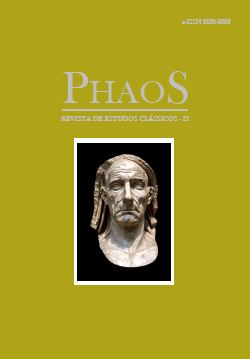Resumen
Este artículo tiene como objetivo discutir la construcción y las funciones del símil en la poesía melic arcaica. Para ello, se presentan algunos de sus aspectos formales y un corpus compuesto por un poema completo, el Epinício 5 de Baquílides (Maehler), y se seleccionan tres fragmentos: el 96 de Safo (Voigt), el 19 de Estesicorus (Davies &Finglass) y el S151 de Ibic (Davies). A lo largo de la argumentación, se consideraron las dificultades de analizar estos símiles, generadas por el estado fragmentario de las canciones y por las diversas posibilidades de interpretación, y las particularidades de las composiciones, que pueden aportar tanto el lenguaje poético tradicional de la época, presente también en los poemas épicos, como imágenes y mitos de la tradición ressignificada.
Citas
AUBRIOT, D. “L’homme-végétal: Métamorphose, Symbole, Métaphore”. In: DELRUELLE, É.; PIRENNE-DELFORGE, V. (Eds.). Κῆποι. De la Religion à la Philosophie. Mélanges Offerts à André Motte. Liège : Centre International d’Étude de la Religion Grecque Antique, 2001, p. 51-62.
BARRON, J. P. The son of Hyllis. The Classical Review, v. 11, 1961, p. 185-187.
BEEKES, R. Etymological Dictionary of Greek. Leiden/Boston: Brill, 2010.
CAREY, C. Stesichorus and the Epic Cycle. In: KELLY, A.; FINGLASS, P. J. (Ed.). Stesichorus in Context. Cambridge: Cambridge University Press, 2015, p. 45-62.
DAVIES, M. (Ed.). Poetarum Melicorum Graecorum Fragmenta. Oxford: Clarendon, 1991.
DAVIES, M.; FINGLASS, P. J. (Ed.). Stesichorus, Cambridge: Cambridge University Press, 2014.
DE KREIJ, M. Part II: Particle Use in Homer and Pindar. In: BONIFAZI, A.; DRUMMEN, A.; DE KREIJ, M. Particles in Ancient Greek Discourse: Five Volumes Exploring Particle Use Across Genres. Washington: Center for Hellenic Studies, 2016. Disponível em: https://chs.harvard.edu/book/bonifazi-drummen-de-kreij-eds-particles-in-ancient-greek-discourse/. Acesso em: 01 maio 2021.
EDWARDS, M. W. The Iliad: a commentary. Volume V: Books 17-20. Cambridge: Cambridge University Press, 1991.
FERRARI, F. Sappho's Gift: The Poet and Her Community. Tradução de: Benjamin Acosta-Hughesand e Lucia Prauscello. Michigan: Ann Arbor, 2010.
FINKELBERG, M. Is KΛΕΟΣ ΑΦθΙΤΟΝ a Homeric Formula? The Classical Quarterly, v. 36, n. 1, p. 1-5, 1986.
FOLEY, J. M. Homer's Traditional Art. Pennsylvania. Pennsylvania: The Pennsylvania State University Press, 1999.
FOWLER, R. L. The Nature of Early Greek Lyric: Three Preliminary Studies. Toronto: University of Toronto Press, 1987.
FRÄNKEL, H. Early Greek Poetry and Philosophy: A History of Greek Epic, Lyric, and Prose to the Middle of the Fifth Century. Tradução de Moses Hadas and James Wilhs. New York/London: Basil Blackwell, 1973.
GENTILI, B.; CATENACCI, C. Polinnia. Poesia Greca Arcaica. Messina: Casa Editrice G. D’Anna, 2007.
HUTCHINSON, G. O. Greek Lyric Poetry: A Commentary on Selected Larger Pieces. Oxford: Oxford University Press, 2001.
HOMERO. Ilíada. Tradução de Christian Werner. São Paulo: Ubu Editora, 2018.
KANTZIOS, I. Pindar's Muses. Classical Bulletin, v. 79, n. 1, p. 3-32, 2003.
KELLY, A. A Referential Commentary and Lexicon to Iliad VIII. Oxford: Oxford University Press, 2007.
KELLY, A. Stesichorus’ Homer. In: KELLY, A.; FINGLASS, P. J. (Ed.). Stesichorus in Context. Cambridge: Cambridge University Press, 2015, p. 21-44.
KELLY, A. Homero nos poetas líricos: recepção e transmissão. Classica - Revista Brasileira de Estudos Clássicos, v. 29, n. 1, p. 125–156, 2016. Disponível em: https://revista.classica.org.br/classica/article/view/410. Acesso em: 5 maio 2021.
LARDINOIS, A. Subject and Circumstance in Sappho’s Poetry. Transactions of the American Philological Association, v. 124, 1994, p. 57-84.
LEFKOWITZ, M. R. Bacchylides' Ode 5: Imitation and Originality. Harvard Studies in Classical Philology, v. 73, p. 45-96, 1969.
MAEHLER, H. (ed.). Bacchylides. Leipzig: Teubner, 2003.
MAEHLER, H. (ed.). Bacchylides: a selection. Cambridge: University Press, 2004.
NAGY, G. Comparative Studies in Greek and Indic Meter. Washington: Harvard University Press, 1974. Disponível em: https://chs.harvard.edu/book/nagy-gregory-comparative-studies-in-greek-and-indic-meter/. Acesso em: 06 fev. 2021.
OLSEN, S. Pindar, Paean 6: Genre as Embodied Cultural Knowledge. In: FOSTER, M.; KURKE, L.; WEISS, N. (Ed.). Genre in Archaic and Classical Greek Poetry: Theories and Models: Studies in Archaic and Classical Greek Song. Leiden/Boston: Brill, 2020, p. 325-346.
PAGE, D. L. (Ed.). Poetae Melici Graeci. Oxford: Clarendon, 1962.
PFEIJFFER, I. L. The Image of the Eagle in Pindar and Bacchylides. Classical Philology, v. 89, n. 4, p. 305-317, out. 1994.
RAGUSA, G. “Heitor e Andrômaca, da festa de bodas à celebração fúnebre: imagens épicas e líricas do casal na Ilíada e em Safo (Fr. 44 Voigt)”. Calíope, v. 15, p. 37-64, 2006.
RAGUSA, G. Safo de Lesbos: Hino a Afrodite e outros poemas. São Paulo: Hedra, 2011.
RAGUSA, G. (Org.). Lira Grega: antologia de poesia arcaica. São Paulo: Hedra, 2013.
RAGUSA, G. A coralidade e o mundo das parthénoi na poesia mélica de Safo. Aletria: Revista de Estudos de Literatura, v. 29, n. 4, p. 85-111, 19 dez. 2019.
READY, J. L. The Homeric Simile in Comparative Perspectives: Oral Traditions from Saudi Arabia to Indonesia. Oxford: Oxford University Press, 2018.
ROOD, N. Craft Similes and the Construction of Heroes in the Iliad. Harvard Studies in Classical Philology, v. 104, p. 19-43, 2008.
RUTHERFORD, I. Paeanic Ambiguity: A Study of the Representation of the παιάν in Greek Literature. Quaderni Urbinati di Cultura Classica, v. 44, n. 2, p. 77-92, 1993.
RUTHERFORD, I. (Ed.). Pindar’s Paeans: A Reading of the Fragments with a Survey of the Genre. Oxford: University Press, 2001.
SCODEL, R. Listening to Homer: Tradition, Narrative & Audience. New York: The University of Michigan Press/Ann Arbor, 2002.
SEGAL, C. Bacchylides Reconsidered: Epithets and the Dynamics of Lyric Narrative. Quaderni Urbinati di Cultura Classica, n. 22, p. 99-130, 1976.
STAFFORD, E. Herackles. London: Routledge, 2012.
TAPLIN, Oliver. Homeric Soundings: The Shaping of the Iliad. Oxford: Clarendon Press, 1992.
TSAGALIS, C. The Oral Palimpsest: Exploring Intertextuality in the Homeric Epics. Washington, DC: Center for Hellenic Studies, 2007. Disponível em: http://nrs.harvard.edu/urn-3:hul.ebook:CHS_TsagalisC.The_Oral_Palimpsest.2008 . Acesso em 09. fev. 2021.
VOIGT, E. M. (Ed.). Sappho et Alcaeus. Amsterdam: Athenaeum, Polak & Van Gennep, 1971.
WILKINSON, C. L. (Introd., Trad., Coment.). The Lyric of Ibycus. Berlin: De Gruyter, 2013.

Esta obra está bajo una licencia internacional Creative Commons Atribución-NoComercial-CompartirIgual 4.0.
Derechos de autor 2021 Gabriela Canazart


